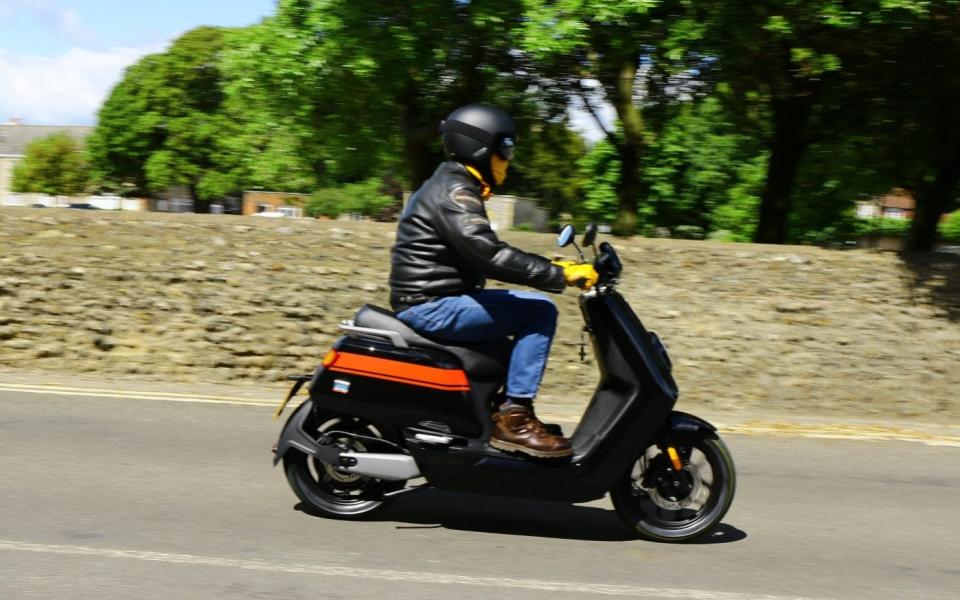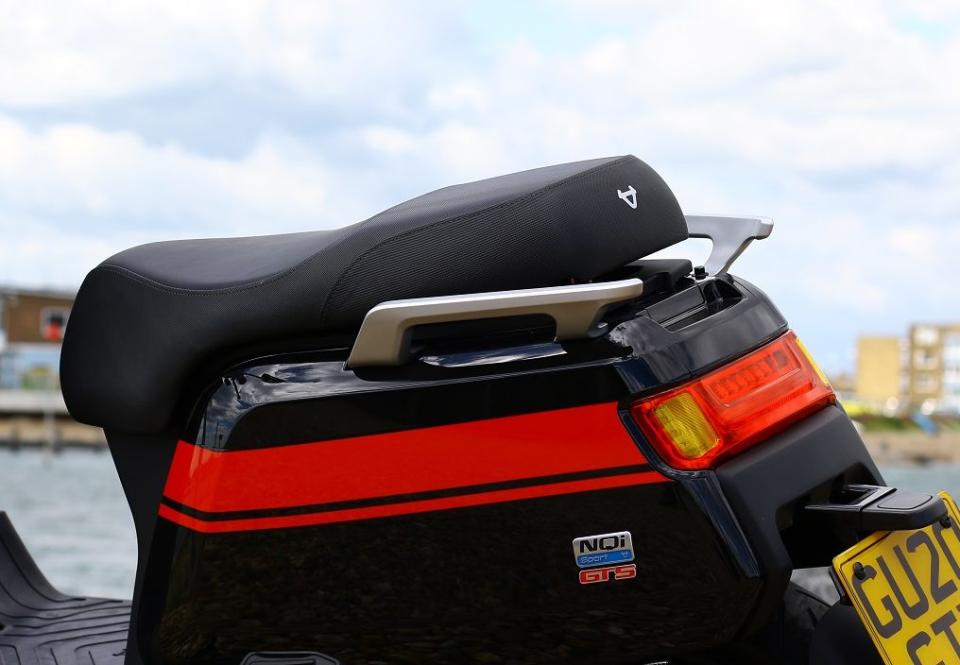NIU NQi GTS Sport electric scooter review: the perfect commuter machine?

Ever seen one of these? You will if you’ve been to China, where electric bicycles, electric scooters, e-scooters and e-skateboards have taken over from the common-or-garden pushbike; one estimate reckons there are 200 million e-bikes in the country.
In cities such as Shanghai, there’s an armada of volt-powered two-wheelers at every intersection and suburban high-rise blocks are besieged by abandoned machines as their removable batteries are charged in flats.
Prepare for, if not the same, then something vaguely similar. There's a big push for electric two-wheelers right now, a recent report suggesting that up to five million (or 17 per cent) of Britain’s 32 million commuters are thinking about two wheels as they look to avoid public transport.
Another report, from IDTechEX, reckons that by 2029 the world market for electric two-wheelers will top $41 billion (£32.4 billion). Mega-investors are licking their lips at the prospect of all that money to be made as concerns about inner-city air quality and traffic congestion meet a post-Covid reluctance to use trains and buses. As we’ve tried to explain in previous articles (https://www.telegraph.co.uk/cars/comment/lockdown-deserve-cogent-debate-commuting-bicycle-e-bike-motorised/), some of this “two wheels good, four wheels bad” movement seems sensible, with other parts looking doctrinaire, overtly political and even downright daft, but since ministers and their unelected advisors won’t be around when (and if) any of it is adopted, who cares?
This vehicle isn’t completing for precious pavement space and it isn’t part of a shouty debate over safety, helmet wearing or youngsters’ riding qualifications. It’s a scooter, it travels on the Queen’s Highway and you require a licence, tax and insurance, and a helmet to ride it. Fall off it and it’s going to hurt, so gloves, goggles and decent boots are recommended.

It’s part of an 11-strong model range of electric two-wheelers from Chinese company NIU, with an importer based in Portslade on the Sussex coast. Founded in 2014, NIU is one of the biggest electric scooter/motorcycle makers on the globe; it has 39.5 per cent of the Chinese market and as of 2019 has produced one million electric scooters and bicycles.
NIU entered the European market in 2016 and it reckons that by 2022 the electric two-wheeler market will be worth almost nine per cent of a £26.3 billion total two-wheeler market in Europe; no mere hill of beans, then.
And the company’s got big ambitions. It opened a new 75-acre factory at Changzhou in China last December capable of making 700,000 machines a year. At this year’s Las Vegas Consumer Electronics Show it showed an electric motorcycle (RQi) and a weird canopied three-wheeler (TQi), which will most likely land on UK shores sometime next year.
The company has recently made the move from Panasonic batteries to EVE units and this is the first such scooter, the £2,956 NQi GTS Sport. We’re the first to test it.

Don’t get too excited, though, it has a maximum speed of 43mph, a range of 60 miles (if you ride it like a priest) and it takes 3.5 hours to charge fully using a household supply. Mild rather than Wild Boys, then, and it’s unsurprising that it is 40-year-old metropolitan creatives rather than Marc Márquez wannabes who have been the first customers.
But nature doesn’t recognise who saved the gram of CO2 and on the latest Government electricity generation figures this little thing has a carbon contribution of 7.6g/km, which is almost 25 per cent of the total 34g/km emitted by Honda’s £3,449 C125 Super Cub, which is the world’s most popular wheeled machine, ever.
This little step-through has its batteries mounted under the seat and under the floor, which can be removed for recharging if you haven’t got a cable. With the batteries in place it weighs 109kg, exactly the same as the Honda Cub. There’s no storage space, but the pillion has a generous seat with proper footrests and a study pair of hand grabs, which you could bungee a tail pack to, or get yourself a back pack.
Construction is a funny mix of traditional cheap scooter in its 14-inch alloy wheels, bent steel bars, stamped steel indicator holders and a steep bent-back riding geometry, along with super-modern displays and snazzy plastic covers. The machine has a Wi-Fi connection, for Pete’s sake, it knows where it is – and also where it’s been taken if it’s nicked.
There’s also a cruise control and a telephone app so you can tell the state of charge, check your riding style, find a service centre and diagnose the scooter’s ECU. I’m not sure I like the fact that NIU is harvesting all this data and boasting about it, but that’s the price you pay for all this connectivity.

It seems well put together. It’s also tiny. Step on and you’ll have to bend forward to reach the grips. A twist of the key and a press of a conventional starter activates the systems and then it’s twist and go…
Except you can’t balance the machine on the back brake as that disengages the drive, so you have to learn how to hill start on the long-travel throttle, which takes some doing for the rider of a conventional motorcycle.
There are three riding modes, with Eco virtually unusable on busy roads, where you depend on a bit of oomph to accelerate out of trouble. Also, against a stiff headwind the machine could barely maintain 30mph in this mode.
Dynamic is better, but frankly I kept it in Sport for most of my 27-mile ride, where the little bike would top out at 43mph. The acceleration isn’t going to challenge your shoulders over much, but in traffic it’s brisk enough to keep up.
I didn’t hang about, but neither did I break the speed limit from Portslade to Worthing and the battery capacity was at 50 per cent when I got to 23 miles, which equates to a 46-mile range. You’d have to ride really slowly to live up to that 60-mile range claim. And while the machine does have some regenerating capacity when you roll off the throttle, it isn’t that effective.

The range claims are only good for 1,000 recharges, whereupon the battery capacity will start to drop; 10 per cent for the next 1,000 charges and so on. A new battery will cost about £700, which is expensive, but then a recharge will cost less than 40 pence and brakes will require less servicing than those of conventional scooters.
On bumpy roads it feels stable, but the ride is choppy and harsh, and while the steering rake is gentle enough for the bike to be controllable in tight turns, it does drop into the corners and you need to have a care when turning into T-junctions.
I liked it quite a lot, but it’s not a proper motorcycle nor a scooter. It’s more of a runabout; great for the seafront commute on a sunny morning, less so on a cold winter evening when you just want to get home. Like a lot of battery-powered two-wheelers, it desperately needs 50 per cent more range and performance.
It's here you might ask yourself what the established Japanese, Italian and UK motorcycle manufacturers have been doing for the last decade and why we aren’t being offered battery-electric scooters and motorcycles from them. Truth is they haven’t been idle, but the machines they’ve developed haven’t been given the go ahead partly because of their cost, over-futuristic style or lack of range/performance. BMW’s electric scooter, for example, the C Evolution, costs more than £14,000.
The Chinese and Taiwanese haven’t been slow to fill the gap, although the road chaos such machines cause, plus the horrendous accident rates and the stress they impose on the generating capacity, means that in certain Chinese cities they’ve actually been banned.
You can also add in American and European anti-dumping legislation, which has drastically reduced Chinese imports of e-bikes, means that companies such as NIU will have to watch their step.
So, could you leave the conventional car at home for the daily commute and ride the NQi instead, and would that be as environmental as forking out for an electric car?
The maths is complicated. According to Department for Transport figures, the average UK mileage for a petrol car in 2018 was about 6,600 miles. Using the latest figures for UK electricity generation, to cover that distance in Honda’s £26,160 'e' electric car would emit 437kg of well-to-wheels CO2. The equivalent distance in the new £18,980 hybrid Jazz would emit 1,104kg of CO2 in tailpipe emissions. You would have to do 60 per cent less mileage in the Jazz to match the e’s CO2 contribution and it seems unlikely you’d replace that near 4,000-mile annual mileage gap on this little scooter.
What you could do is close that gap, however. So average British commuting in 2018 was 2,600 miles, which if done on this scooter would emit just 31.4kg of CO2, which would take over 404kg of CO2 out of the atmosphere by leaving a Jazz at home.
Of course, you can push and pull at these figures and they take no account of the well-to-pump contribution of the petrol extraction, refining and delivery, or the considerable charging or transmission losses for electricity. A more efficient diesel alternative could bring the electric-to-combustion ratio down to about 50 per cent, but then diesel cars tend to cover higher mileages.
What’s clear, however, is that on a half-decent day the NQi can be a fun and involving way of getting to work and it does the planet a bit of good, too.
As far as the future is concerned, ambition is all very well, but NIU will have to back up its boasts with serious product development. As they arrive in the sophisticated European markets, electric two-wheelers are at the start of their development journey.
For some folk, the NQi GTS Sport will fill a gap in their commuting requirements, but it’s no substitute for a 125cc commuter. Next year’s NIU battery motorcycle is going to be very interesting – and possibly worrying for existing motorcycle manufacturers.
The facts
NIU NQi GTS Sport
Price (OTR): £2,956 including 20 per cent Government OLEV grant
Battery: two EVE 60-volt 26Ah units under the floor and under the seat
Continuous power output: 3,100 watts
Battery capacity in total: 3.12kWh
Weight including batteries: 109kg
Seat height: 820mm,
Range: 60 miles
Wheel size: 14 inches
Top speed: 43.5mph
CO2 well to wheels: 7.6g/kWh
Contact: https://www.sinnismotorcycles.com/
For tips and advice, visit our Advice section, or sign up to our newsletter here
To talk all things motoring with the Telegraph Cars team join the Telegraph Motoring Club Facebook group here


